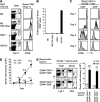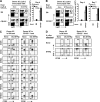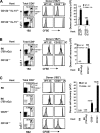An intense form of homeostatic proliferation of naive CD8+ cells driven by IL-2
- PMID: 17664294
- PMCID: PMC2118670
- DOI: 10.1084/jem.20070740
An intense form of homeostatic proliferation of naive CD8+ cells driven by IL-2
Abstract
In conditions of T lymphopenia, interleukin (IL) 7 levels rise and, via T cell receptor for antigen-self-major histocompatibility complex (MHC) interaction, induce residual naive T cells to proliferate. This pattern of lymphopenia-induced "homeostatic" proliferation is typically quite slow and causes a gradual increase in total T cell numbers and differentiation into cells with features of memory cells. In contrast, we describe a novel form of homeostatic proliferation that occurs when naive T cells encounter raised levels of IL-2 and IL-15 in vivo. In this situation, CD8(+) T cells undergo massive expansion and rapid differentiation into effector cells, thus closely resembling the T cell response to foreign antigens. However, the responses induced by IL-2/IL-15 are not seen in MHC-deficient hosts, implying that the responses are driven by self-ligands. Hence, homeostatic proliferation of naive T cells can be either slow or fast, with the quality of the response to self being dictated by the particular cytokine (IL-7 vs. IL-2/IL-15) concerned. The relevance of the data to the gradual transition of naive T cells into memory-phenotype (MP) cells with age is discussed.
Figures








Similar articles
-
IL-15 is critical for the maintenance and innate functions of self-specific CD8(+) T cells.Eur J Immunol. 2009 Jul;39(7):1784-93. doi: 10.1002/eji.200839106. Eur J Immunol. 2009. PMID: 19544306
-
IL-15 mimics T cell receptor crosslinking in the induction of cellular proliferation, gene expression, and cytotoxicity in CD8+ memory T cells.Proc Natl Acad Sci U S A. 2002 Apr 30;99(9):6192-7. doi: 10.1073/pnas.092675799. Epub 2002 Apr 23. Proc Natl Acad Sci U S A. 2002. PMID: 11972069 Free PMC article.
-
Homeostasis of naive and memory T cells.Immunity. 2008 Dec 19;29(6):848-62. doi: 10.1016/j.immuni.2008.11.002. Immunity. 2008. PMID: 19100699 Review.
-
TLR2 engagement on memory CD8(+) T cells improves their cytokine-mediated proliferation and IFN-gamma secretion in the absence of Ag.Eur J Immunol. 2009 Oct;39(10):2673-81. doi: 10.1002/eji.200939627. Eur J Immunol. 2009. PMID: 19634192
-
Homeostatic proliferation and survival of naïve and memory T cells.Eur J Immunol. 2009 Aug;39(8):2088-94. doi: 10.1002/eji.200939444. Eur J Immunol. 2009. PMID: 19637200 Review.
Cited by
-
Naïve CD8(+) T cell derived tumor-specific cytotoxic effectors as a potential remedy for overcoming TGF-β immunosuppression in the tumor microenvironment.Sci Rep. 2016 Jun 16;6:28208. doi: 10.1038/srep28208. Sci Rep. 2016. PMID: 27306834 Free PMC article.
-
IL-12 Signals through the TCR To Support CD8 Innate Immune Responses.J Immunol. 2016 Sep 15;197(6):2434-43. doi: 10.4049/jimmunol.1600037. Epub 2016 Aug 12. J Immunol. 2016. PMID: 27521342 Free PMC article.
-
Extending the lifespan and efficacies of immune cells used in adoptive transfer for cancer immunotherapies-A review.Oncoimmunology. 2015 Mar 19;4(4):e1002720. doi: 10.1080/2162402X.2014.1002720. eCollection 2015 Apr. Oncoimmunology. 2015. PMID: 26155387 Free PMC article. Review.
-
The antigen-specific CD8+ T cell repertoire in unimmunized mice includes memory phenotype cells bearing markers of homeostatic expansion.J Exp Med. 2009 Feb 16;206(2):435-48. doi: 10.1084/jem.20081829. Epub 2009 Feb 2. J Exp Med. 2009. PMID: 19188498 Free PMC article.
-
Foreign antigen-independent memory-phenotype CD4+ T cells: a new player in innate immunity?Nat Rev Immunol. 2018 Feb 26;18(3):1. doi: 10.1038/nri.2018.13. Nat Rev Immunol. 2018. PMID: 29480288 Free PMC article.
References
-
- Sprent, J. 1993. Lifespans of naive, memory and effector lymphocytes. Curr. Opin. Immunol. 5:433–438. - PubMed
-
- Freitas, A.A., and B.B. Rocha. 1993. Lymphocyte lifespans: homeostasis, selection and competition. Immunol. Today. 14:25–29. - PubMed
-
- Tanchot, C., F.A. Lemonnier, B. Perarnau, A.A. Freitas, and B. Rocha. 1997. Differential requirements for survival and proliferation of CD8 naive or memory T cells. Science. 276:2057–2062. - PubMed
Publication types
MeSH terms
Substances
LinkOut - more resources
Full Text Sources
Molecular Biology Databases
Research Materials

